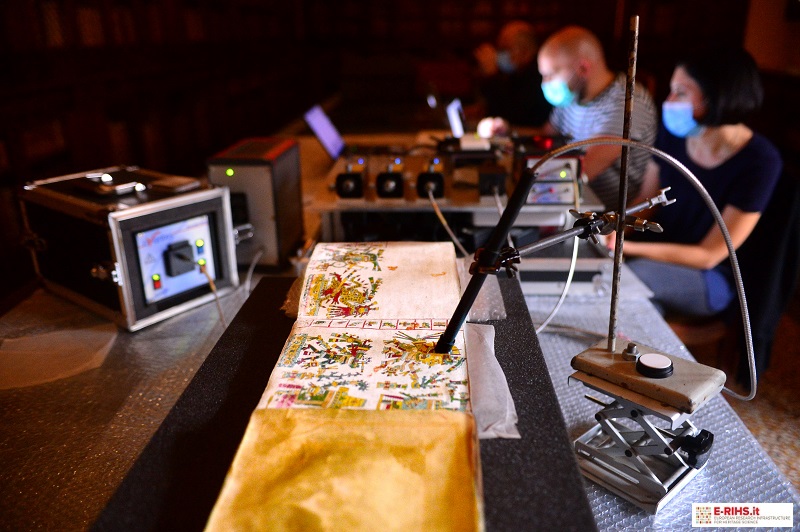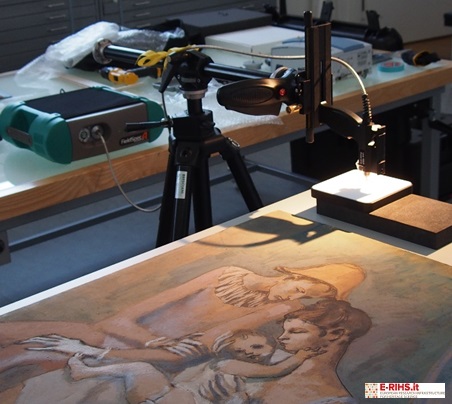
LABORATORY: SMAArt-UNIPG
NAME OF THE INSTRUMENT
Integrated spectroscopic system for Reflectance and UV-VIS-NIR Fluorescence (prototype)
GENERAL DESCRIPTION
In situ UV-VIS-NIR reflectance and fluorescence spectroscopies have become, in recent years, an effective non-invasive technique for the identification of different organic and inorganic materials used in the production of artworks such as paintings, manuscripts, fabrics, etc. For these purposes, fluorescence measurements are particularly suitable for the characterization of organic dyes and luminescent pigments such as, for example, zinc oxide, cadmium-based pigments and Egyptian Blue. Furthermore, different fluorophores with similar emission spectra can sometimes be separated and recognized on the basis of their emission lifetime.
TECHNICAL DESCRIPTION
The portable prototype is composed of several light sources: a compact deuterium-halogen lamp for reflectance measurements; solid state lasers and laser diodes for steady state fluorescence measurements; Pulsed diodes and LEDs for emission lifetimes determination in the ns to ms time range.
The sources are coupled with high-sensitivity CCD spectrometers that work in the UV-VIS-NIR spectral range and which allow to acquire reflectance spectra in the 200-1600 nm spectral range and luminescence spectra in the 300-1600 nm range. Lifetimes can be measured for species emitting in the 350-850 nm spectral range.
A dedicated fiber optic system allows measurements to be performed on any surface with a spatial resolution of less than 2 mm.2.
Referents:
Aldo Romani aldo.romani@unipg.it

LABORATORY CNR-SCITEC
NAME OF THE INSTRUMENT
ASD FieldSpec 4 High Resolution spectrometer (350-2500 nm)
GENERAL DESCRIPTION
In the last years, in-situ UV-VIS-NIR reflectance spectroscopy has become an effective non-invasive technique for the identification of different organic and inorganic materials in art objects such as paintings, manuscripts, textiles, etc. The absorptions due to electronic and vibrational transitions in the broad spectral window from visible to SWIR (400-2500 nm), can be exploited for the identification of most of the pigments and the characterization of several organic materials.
TECHNICAL DESCRIPTION
The instrumnet is equipped with three detectors: a 512 element silicon array detector for the 350-1000 nm range, and two InGaAs Photodiodes (TE Cooled) for the 1000-1800 and the 1800-2500 nm ranges. The spectral resolution is 3 nm in the VNIR range (350-1000 nm) and 10 nm in the SWIR range (1000-2500 nm). A complete spectrum can be recorded in the scanning time of 0.1 s.
The instrument is supplied with a 1 m long optical fiber directly connected to the spectrophotometer with a 25° FOV. Using an external lighting consisting of a 12V quartz-tungsten lamp with ventilated cooling (placed at 45° with respect to the surface) and the permanent fiber (placed perpendicular to the surface), measurements with CIE 45/0 geometry can be carried out. The lateral resolution in this setup depends on the working distance: indicatively, the measurement area is about half of the working distance. Alternatively, the instrument is equipped with two bifurcated fiber optic systems (large and small diameter reflectance probe) which can be connected to the permanent fiber and to an external source with nominal power 12VDC, 30W. The large diameter reflectance probe consists of 156 fibers (200 micron), 78 for the excitation and 78 for collecting the reflected light, the stainless steel tip has a diameter of 6.3 mm . The large diameter fiber can be used with a collection probe for reflected light at approximately 20°. The small diameter reflectance probe is composed of 6 illumination fibers (600 microns) surrounding a single collection fiber (600 microns), the stainless steel tip has a diameter of 6.3 mm .large diameter reflectance probe) which can be connected to the permanent fiber and to an external source with nominal power 12VDC, 30W. The large diameter reflectance probe consists of 156 fibers (200 micron), 78 for the excitation and 78 for collecting the reflected light, the stainless steel tip has a diameter of 6.3 mm . The large diameter fiber can be used with a collection probe for reflected light at approximately 20°.(The small diameter reflectance probe is composed of 6 illumination fibers (600 microns) surrounding a single collection fiber (600 microns), the stainless steel tip has a diameter of 6.3 mm .
SpectralonTM is used for the white reference calibration, and RS3 Software Package A3500370 is used for data acquisition. A backpack and batteries are provided for standing-up analysis.
Referent:
Francesca Rosi francesca.rosi@cnr.it
